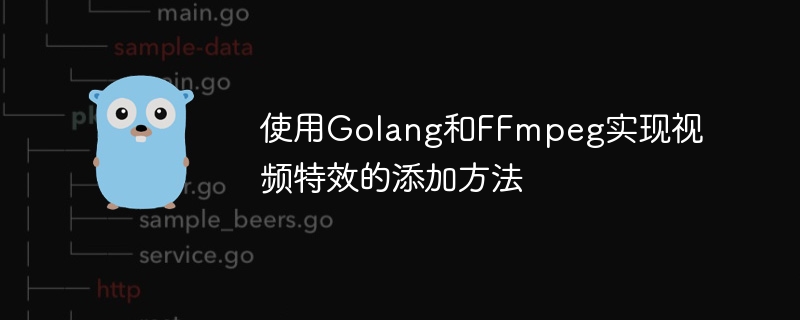

How to add video special effects using Golang and FFmpeg
Abstract:
Video special effects are a very important link in modern film and television production. Add a variety of special effects to enhance the viewing quality and artistry of the video. This article will introduce how to use Golang and FFmpeg libraries to add video special effects, and provide specific code examples.
Introducing the FFmpeg library
First, we need to introduce the FFmpeg library into the Golang code. You can use the go get command to download the Golang bindings for the FFmpeg library. Execute the following command in the terminal:
go get github.com/vansante/go-ffmpeg
Then, import the FFmpeg library in the Golang code:
import ( "github.com/vansante/go-ffmpeg" )
Open the video file
Before adding video effects, we You need to open the video file first. You can use the Open function provided by the FFmpeg library to open a video file and return an object representing the video file. The code is as follows:
func OpenVideoFile(filepath string) (*ffmpeg.Video, error) {
video := ffmpeg.NewVideo(filepath)
err := video.Open()
if err != nil {
return nil, err
}
return video, nil
}Among them, filepath is the path of the video file.
Add video special effects
Once the video file is opened, we can add video special effects through the methods provided by the FFmpeg library. Here, we take adding a black and white effect as an example. The code is as follows:
func AddEffect(video *ffmpeg.Video) error {
err := video.VideoFilter("hue='H=0'")
if err != nil {
return err
}
err = video.SaveToFile("output.mp4")
if err != nil {
return err
}
return nil
}Among them, video.VideoFilter("hue='H=0'") converts the video to black and white effect, and video.SaveToFile("output.mp4") saves the processed video as output.mp4 file.
Complete sample code
The following is a complete sample code using Golang and FFmpeg to add video special effects:
package main
import (
"fmt"
"github.com/vansante/go-ffmpeg"
)
func OpenVideoFile(filepath string) (*ffmpeg.Video, error) {
video := ffmpeg.NewVideo(filepath)
err := video.Open()
if err != nil {
return nil, err
}
return video, nil
}
func AddEffect(video *ffmpeg.Video) error {
err := video.VideoFilter("hue='H=0'")
if err != nil {
return err
}
err = video.SaveToFile("output.mp4")
if err != nil {
return err
}
return nil
}
func main() {
video, err := OpenVideoFile("input.mp4")
if err != nil {
fmt.Println("Failed to open video file:", err)
return
}
err = AddEffect(video)
if err != nil {
fmt.Println("Failed to add effect:", err)
return
}
fmt.Println("Video effect added successfully!")
}Summary:
This article introduces the method of using Golang and FFmpeg libraries to add video special effects, and provides specific code examples. Readers can further expand and optimize the code according to their own needs to achieve more rich video special effects. By learning and using these tools and techniques, we can better improve the viewing quality and artistry of the film, and create better film and television works.
The above is the detailed content of How to add video special effects using Golang and FFmpeg. For more information, please follow other related articles on the PHP Chinese website!




